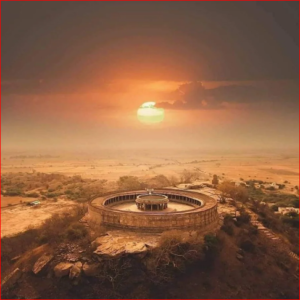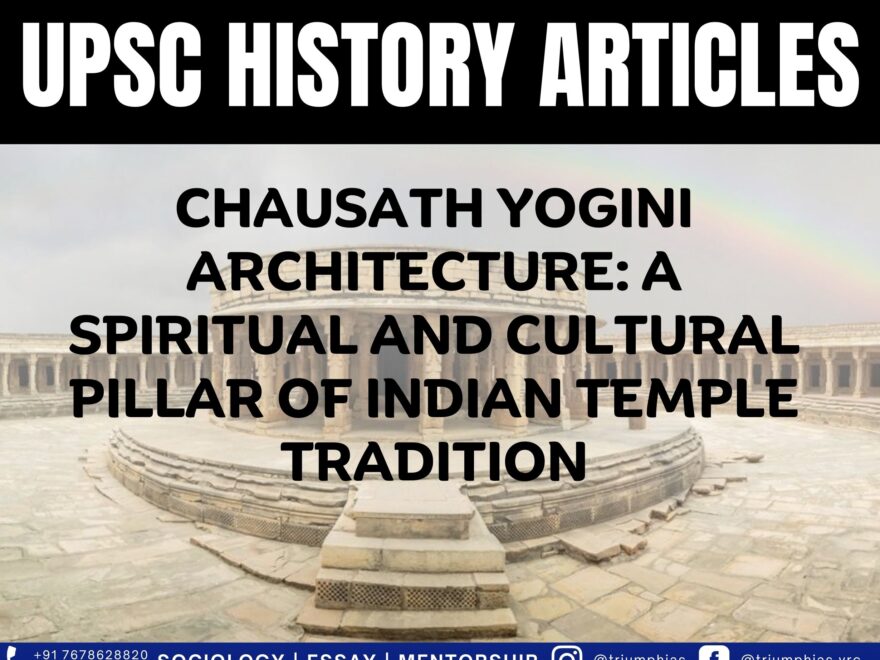Chausath Yogini Architecture
(Relevant for Historical Section of General Studies Paper Prelims/Mains)

Chausath Yogini Architecture
Chausath Yogini Architecture represents a unique form of temple architecture constructed between the 9th and 11th centuries. These temples feature recesses for 64 yoginis, women who practice yoga, which is why they are named Chausath Yogini Temples. Typically, these temples are devoted to either Shiva or Bhairava, with the deity placed at the heart of the courtyard. These yoginis are portrayed as formidable and intense manifestations of the divine feminine, frequently linked with tantric traditions and ceremonies.
Significance of Chausath Yogini Architecture:
The significance of Chausath Yogini Architecture within the Indian temple tradition is rooted in its portrayal of cosmic energy and the dynamic interplay between Shiva and Shakti. The circular design of these temples represents the cyclical nature of time and the cosmic harmony. The yoginis are regarded as embodiments of Shakti, emerging from Shiva and encircling him in a protective formation. They also symbolize various facets of human nature, emotions, aspirations, and abilities.
Devotees who venerate the yoginis aim to reconcile their internal and external realms, striving for spiritual liberation.
Chausath Yogini architecture mirrors numerous socio-cultural and religious aspects of the period in which it emerged, offering insights into the prevalent beliefs, rituals, and societal dynamics of that epoch.
Goddess Worship and Divine Femininity: Chausath Yogini temples pay homage to the feminine divine during their historical period and are dedicated to the 64 female attendants of goddess Durga, known as Yoginis. The portrayal of these formidable female figures underscores the concept of Shakti, the divine feminine energy, and acknowledges the spiritual strength and impact of women.
Yogic and Tantric Influences: Yoginis are depicted in yogic poses, reflecting the influence of yogic and tantric traditions of that time. Yoga and meditation were considered pathways to attain spiritual enlightenment and transcendence.
Simplicity and Austerity: Chausath Yogini temples stand out with their simple and austere architectural style. In comparison to the temple structures of earlier eras, these temples exhibit a more minimalistic design. The absence of elaborate superstructures and excessive ornamentation signifies a shift towards a more uncomplicated and spiritually centered approach to worship.
Symbolism of Circular Architecture: The circular or octagonal layout of Chausath Yogini temples symbolizes the cosmic configuration of the universe, mirroring the belief in the cyclical nature of time. It embodies the chakra, representing the cosmic arrangement and the perpetual flow of energy. This encapsulates a profound metaphysical comprehension and a worldview rooted in cosmic equilibrium and harmony.
Chausath Yogini Architecture carries great importance within the context of the Indian temple tradition. Its distinctive circular or octagonal arrangement, emphasis on yogini goddesses, and embodiment of socio-cultural and religious characteristics of its contemporary era establish it as a unique and impactful architectural style. The impact of Chausath Yogini Architecture is evident in later temple constructions, cementing its role in the progression of Indian temple architecture.
Sample Question for UPSC Sociology Optional Paper:
Question 1: What is the historical period in which Chausath Yogini Architecture emerged?
Short Answer: Chausath Yogini Architecture emerged between the 9th and 11th centuries.
Question 2: Who are typically the central deities in Chausath Yogini temples?
Short Answer: The central deities in Chausath Yogini temples are usually either Shiva or Bhairava.
Question 3: What does the circular design of Chausath Yogini temples signify?
Short Answer: The circular design represents the cyclical nature of time and the cosmic harmony between Shiva and Shakti.
Question 4: What societal beliefs and values are reflected in Chausath Yogini architecture?
Short Answer: The architecture mirrors the socio-cultural and religious beliefs, rituals, and dynamics of its epoch, including the emphasis on the divine feminine and the influences of yogic and tantric traditions.
Question 5: How do Chausath Yogini temples differ architecturally from earlier Indian temples?
Short Answer: Chausath Yogini temples are distinct in their simpler and more austere architectural style, lacking elaborate superstructures and excessive ornamentation, signifying a more spiritually-centered approach to worship.
To master these intricacies and fare well in the Sociology Optional Syllabus, aspiring sociologists might benefit from guidance by the Best Sociology Optional Teacher and participation in the Best Sociology Optional Coaching. These avenues provide comprehensive assistance, ensuring a solid understanding of sociology’s diverse methodologies and techniques.
Chausath Yogini Architecture, Indian Temple Tradition, Divine Feminine, Shiva, Shakti, Cosmic Energy, Tantric Traditions, Yoga, Circular Architecture, Spiritual Liberation, 9th Century, 11th Century, Chausath Yogini Architecture, Indian Temple Tradition, Chausath Yogini Architecture, Indian Temple Tradition, Chausath Yogini Architecture, Indian Temple Tradition,

Choose The Best Sociology Optional Teacher for IAS Preparation?
At the beginning of the journey for Civil Services Examination preparation, many students face a pivotal decision – selecting their optional subject. Questions such as “which optional subject is the best?” and “which optional subject is the most scoring?” frequently come to mind. Choosing the right optional subject, like choosing the best sociology optional teacher, is a subjective yet vital step that requires a thoughtful decision based on facts. A misstep in this crucial decision can indeed prove disastrous.
Ever since the exam pattern was revamped in 2013, the UPSC has eliminated the need for a second optional subject. Now, candidates have to choose only one optional subject for the UPSC Mains, which has two papers of 250 marks each. One of the compelling choices for many has been the sociology optional. However, it’s strongly advised to decide on your optional subject for mains well ahead of time to get sufficient time to complete the syllabus. After all, most students score similarly in General Studies Papers; it’s the score in the optional subject & essay that contributes significantly to the final selection.
“A sound strategy does not rely solely on the popular
Opinion of toppers or famous YouTubers cum teachers.”
It requires understanding one’s ability, interest, and the relevance of the subject, not just for the exam but also for life in general. Hence, when selecting the best sociology teacher, one must consider the usefulness of sociology optional coaching in General Studies, Essay, and Personality Test.
The choice of the optional subject should be based on objective criteria, such as the nature, scope, and size of the syllabus, uniformity and stability in the question pattern, relevance of the syllabic content in daily life in society, and the availability of study material and guidance. For example, choosing the best sociology optional coaching can ensure access to top-quality study materials and experienced teachers. Always remember, the approach of the UPSC optional subject differs from your academic studies of subjects. Therefore, before settling for sociology optional, you need to analyze the syllabus, previous years’ pattern, subject requirements (be it ideal, visionary, numerical, conceptual theoretical), and your comfort level with the subject.
This decision marks a critical point in your UPSC – CSE journey, potentially determining your success in a career in IAS/Civil Services. Therefore, it’s crucial to choose wisely, whether it’s the optional subject or the best sociology optional teacher. Always base your decision on accurate facts, and never let your emotional biases guide your choices. After all, the search for the best sociology optional coaching is about finding the perfect fit for your unique academic needs and aspirations.
To master these intricacies and fare well in the Sociology Optional Syllabus, aspiring sociologists might benefit from guidance by the Best Sociology Optional Teacher and participation in the Best Sociology Optional Coaching. These avenues provide comprehensive assistance, ensuring a solid understanding of sociology’s diverse methodologies and techniques. Sociology, Social theory, Best Sociology Optional Teacher, Best Sociology Optional Coaching, Sociology Optional Syllabus.
Best Sociology Optional Teacher, Sociology Syllabus, Sociology Optional, Sociology Optional Coaching, Best Sociology Optional Coaching, Best Sociology Teacher, Sociology Course, Sociology Teacher, Sociology Foundation, Sociology Foundation Course, Sociology Optional UPSC, Sociology for IAS,
Follow us :


https://t.me/VikashRanjanSociology
Find More Blogs
|
Scope of the subject and comparison with other social sciences |
|||
|
|
|
|
Modernity and social changes in Europe |

